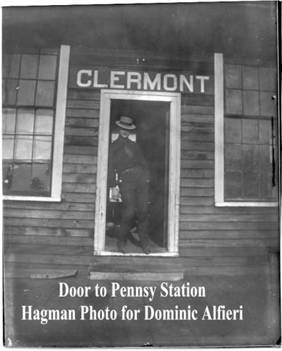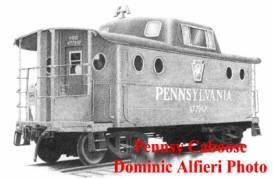With the absorption of the other line The Pennsylvania Railroad became one of the lines through Clermont. To Clermont residents it was always called the “Pennsy”. A station and a house for the station agent were built immediately. The first station agent for the railroad was W. E. Butts. He and his wife were the first occupants of the house. Ben H. Clark later became agent and also occupied the house. The last station agent and also an occupant was Archie Mencer.


1. Station agent's House 2.
Odd Fellows Hall
3. Decker's Boarding House 4. Pennsy Railroad Station

The railroad approached
Clermont from the East following the stream, “ Red Mill Brook”, from present
day Colegrove. Two Miles East of the Station a large pond was built known to all
as the “Pennsy Pond”.

For
many years the pond served as the official swimming hole for the village. It was
very deep and a tragedy occurred there on July 4, 1930. Two boys from the Fuller
family drown there. One was in danger and the other brother swam out to save him
but was pulled under and both drowned. For
many years after that it continued to serve as a swimming place local kids and a
few adults. It also was a favorite fishing place for many youngsters with a nice
supply of sunfish, bluegills, and bullheads available.
From here the railroad continued to the village and then developed
three branches. One turned to the right and served as a siding for the clay
factory. Another went to the right of the present day Alfieri property to
Johnsonburg and points beyond. The other branch passed to the left and
eventually joined the Shawmut railroad at was known as the “Y”.
There were seven sets of tracks just east of the station that served as sidings for storing railroad cars. Beyond these toward the Pennsy pond and across from the famous “Patch” was the turntable used by the line for turning engines around.

Several important functions were carried out by this railroad. It served
as a hauler of both lumber and coal from the Clermont area. The first Buffalo
Coal Company mine was located near the WNY and P Railroad station, and opened in
1874. This was the largest and most profitable mine worked in

It
also provided passenger service to residents both toward

Even
in winter the railroad operated in the hauling of coal and logs.
With harsh winters at that time with huge amounts of snow it was
necessary to keep the tracks clean. A
train engine was used for this purpose as seen in the next photo.

With the numerous trains that were passing through
it was inevitable that some accidents would result. One of these occurred right
along side of Butt’s store as shown in the following photo.

With
the dwindling supply of lumber and the poor supply of coal the Pennsy withdrew
its lines from the area in the early 1930’s.


![]()